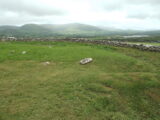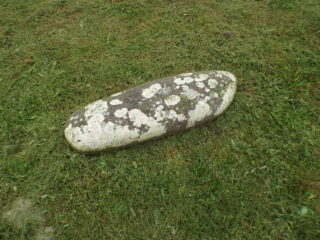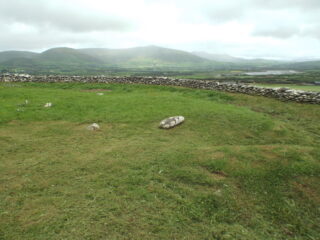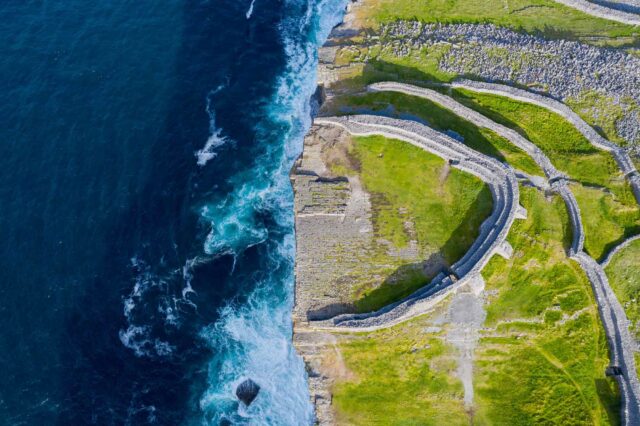Fógra
WARNING: It should be noted that these sites are unguided and a level of care and caution should be maintained during all stages of your visit. The Office Of Public Works (OPW) will not be held responsible for any damages, injuries, or losses that occur
Ballintaggart Ogham Stones
Ballintaggart, located a short distance from the Dingle Racecourse a few km east of Dingle town, is the site of an early Christian monastery probably dating to the 5th All that remains of the church building is a small circular earthen enclosure approximately 30 metres in diameter. The original wooden buildings have long since rotted away and, if they were replaced by later stone buildings as was common, none of these now survive. This ancient church site is the origin of the townland’s place name: Báile an tSagairt, from the Irish meaning the Town/Place of the Priest. However, in the local Irish dialect the site is also referred to variously as An Cheallúnach (The Old Churchyard) or An Lisín (The Small Earthen Fort). Long after it ceased to be used as a monastic site Ballintaggart continued to be used for burials, particularly of unbaptised children – a practice which continued until at least the 1930s.
The most significant feature of the site are the nine ogham stones which are located there. Ogham is an ancient Irish alphabet and our earliest written source for the Irish language. The ogham alphabet uses a script made of lines cut on, across, or either side of, a central 'stem' line. Ogham inscriptions were usually written vertically and are read from bottom to top. These 'ogham stones' appear to have been erected either as memorials or territorial markers and usually record the name of a person with a standard formula such as: “X son of Y, member of the tribe of Z”. Although the alphabet was designed for the Irish language, a few Latin inscriptions in ogham also survive in Ireland. There are about 400 surviving ogham inscriptions. Approximately 350 of these are in Ireland, with the largest number of ogham stones located in counties Cork, Kerry, and Waterford. Around 50 ogham inscriptions have been discovered in Britain with ogham stones located in Wales, Scotland, The Isle of Mann, and in Cornwall and western England.
The nine ogham stones at Ballintaggart are all made from large oval water rolled sandstones which were sourced on Minard Beach, further east of the Dingle Peninsula. Four of the nine stones also have simple crosses inscribed on them. A number of the stones also refer to the tribe or clan name DOVINIAS meaning (of Duibne) from which the local Gaeltacht still takes its name “Corca Duibhne”.
The inscriptions on the nine ogham stones read:
AKEVRITTI (presumably a personal name)
MAQQI-IARI KOỊ MA/QQI MU/CCOI DOVVINIAS (Here is Mac-Iair, son of the Corcu Duibne)
DOVETI MAQQI/ CATTI/NI (of Duibthe, son of Caitne). The language used here is primitive, lacking vowel affection, placing it around the time of Saint Patrick
SUVALLOS MAQ/Q̣Ị DU/COVAROS (of Suvallos son of Ducovaros)
ṂẠQI-DECC[E]DẠ/ ṂẠQ̣Ị/ GLASICONAS (of son of Deichet, son of Glasiconas). The personal name Glasiconas means "grey wolf."
TRIA MAQA MAILAGNI (of the three sons of Maílagnas) / CURCITTI (of Cuircthe). This stone bears a strange cross: with arms of equal length, two with "E" shapes on the end, one with a "Y" and one with a +
INISSIO/NAS (a personal name); like CIIC 157 it dates to the 5th century AD
CUṆẠMAQQ̣I/ AVI CỌRBBI (of Conmac, grandson of Corb)
N[E]TTA-LAMINACCA KO/I ṂA/QQI MỤCOI DOṾ[I]Ṇ[IA]Ṣ (here is Laminacca's champion, son of the Corcu Duibne)
For more information on these stones and their inscriptions visit: https://ogham.celt.dias.ie/
Visit Historic Environment Viewer for more information on Ballintaggart Ogham Stones
Protect our Past - Click here to read about the importance of protecting our country’s unique heritage sites
This national monument is protected in accordance with the National Monuments Acts 1930 to 2014



